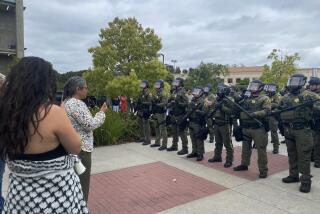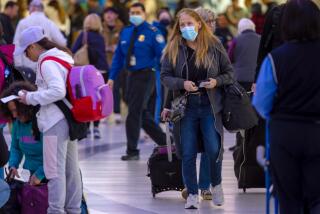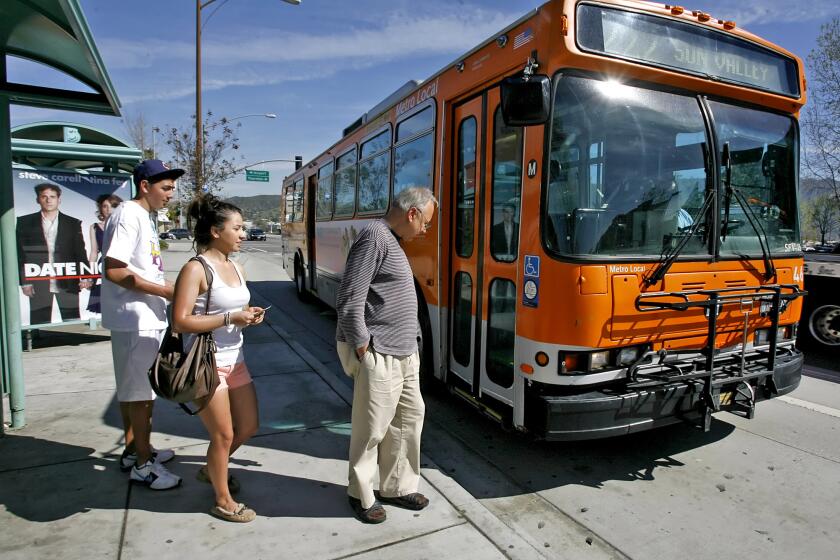A Tale of Two Regional Airports : Bakersfield’s Air Service Fades While Fresno Gains a Wealth of New Carriers
Through the morning haze, Lawrence Galinda watched passengers board two commuter airplanes one day recently at otherwise deserted Meadows Field in Bakersfield. “That’s busy for us,” he said wryly.
In a few weeks, the airport will be quieter still. On May 2, Continental Airlines is stopping service to the city after losing $2.5 million in a little less than a year on its Bakersfield routes.
Continental’s decision created a stir throughout Kern County, where Galinda, the airport manager, led a campaign in an effort to change Continental’s mind. The county spent $10,000 to plaster the roadways with billboards that urged: “Fly Meadows Field.” Local travel agents encouraged clients to fly Continental.
When Continental leaves Bakersfield for good, the city will be left with airline service by just American Airlines and three commuter airlines. “It will be years before we rebuild the service we lost,” Galinda said.
In Fresno, just about 100 up the San Joaquin Valley from Bakersfield, a construction crew is busy expanding the administration building at the city’s Fresno Air Terminal. Next, airport manager Ralph G. Tonseth wants to build more terminals as part of a $35-million expansion.
Just four years ago, air service was so poor in Fresno that the city almost started its own airline. Now such airlines as Delta, Continental and USAir fly to Fresno, and the airport’s gates are full.
“Our biggest problem is that we’re too crowded,” Tonseth said. “If a new airline wanted to come into Fresno right now, I’m not sure we’d have the space.”
The widely different fortunes of the airports at Fresno and Bakersfield reflect changes under way at many regional airports in California. As the major airlines’ profits come under pressure, they are taking a second look at their operations in smaller cities.
Until recently, most smaller California airports had shown gains in passenger traffic, largely due to the explosive growth of commuter airlines. Figures provided by the state Department of Transportation show that five of the state’s smaller airports--Arcata, Bakersfield, Palm Springs, San Luis Obispo and Santa Barbara--grew by more than 10% a year between 1982 and 1986.
The growth in Palm Springs and Santa Barbara has been driven by the increased popularity of those towns as resorts, according to the managers of their airports. San Luis Obispo grew because it is the headquarters for Wings West, a fast-growing commuter airline that flies under the American Eagle name. Arcata and Bakersfield benefited from the arrival of United Airlines, which pulled out of both towns last fall.
Most forecasters expect airport growth to slow as major airlines withdraw from smaller markets. Additionally, commuter airlines are expected to grow at a slower pace. “Commuters stimulate a market by adding flights, but you can only stimulate a small market so much,” said Gene Mercer, chief forecaster for the Federal Aviation Administration in Washington.
Striking Contrast
Over the next few years, the differences between Fresno and Bakersfield will widen, according to a preliminary forecast by Caltrans, as the transportation department is known. The number of passengers using Meadows Field is expected to decline by about 30% to 179,000 in 1990 from the present 250,000. Meanwhile, the number using Fresno Air Terminal, the largest of the state’s small regional airports, is expected to remain fairly stable, at around 870,000.
Even now, the contrast between the two airports is striking. Bordering Fresno’s airport are several landscaped office parks, with such tenants as Wang, a computer company, Ticor Title, and Campbell Soup. The airport plans to develop its own 100-acre office park there.
Meadows Fields is, as its name suggests, bordered by farmland. Directly across from the airport’s entrance, a developer has broken ground for a development of $70,000 homes. The airport is located in the city’s Oildale section, where unemployment is at 8% due to the slump in the oil business. Statewide, unemployment is at around 5%.
Decisions by airlines to enter or leave cities have a broad impact. Good air service is as important to industry as cheap land or low-cost labor, said John Quiring, Fresno’s economic development director. “There are many companies that would not be here without an airport.”
The airport was one reason that Dun & Bradstreet selected Fresno as its Western regional headquarters last fall over Sacramento, Modesto and other towns. “Fresno had less fog than Sacramento and seemed to have better (airline) service than other similar cities,” Lawrence Thompson, a D&B; vice president, said.
Three years ago, Bakersfield lost a prospective employer--a U.S. Bureau of Printing and Engraving facility--because of its poor air service. “Industry won’t locate here if we don’t have good air service,” said Mary K. Shell, a Kern County supervisor and a former mayor of Bakersfield.
Smaller towns try hard to attract airlines. Modesto, another San Joaquin Valley community, hired Boston consultant Lois Kramer to recruit a big airline for its airport. So far, Delta and America West Airlines have turned her down, at least for now.
“The airlines are very conservative,” she said. “No one wants to try an untested market.”
Dean Hill, Delta’s manager for route development, said the idea of a Modesto service by Delta “is not unreasonable, but nothing we’ll do in the near future.” He said the airline’s fleet is committed to other routes. “You only have so many planes in your fleet. You have to prioritize your opportunities.”
In 1985, officials in Fresno lured West Air, a big commuter airline, from Chico--about 250 miles to the north in the Sacramento Valley--by arguing that Fresno is better located for West Air’s operations and by offering a cut rate on office rents. Fresno airport director Tonseth recalls that he visited dozens of West Air employees at their homes to persuade them that Fresno is a nice place to live.
Since the commuter line, also known as United Express, moved to Fresno, it has become the largest air carrier based in California--partly because AirCal of Newport Beach and Pacific Southwest Airlines of San Diego have recently been merged into airlines based in other states.
Rather than going after commuter airlines, however, most ambitious towns try to recruit major airlines, such as United or American, that fly large jets to out-of-state cities. One reason for this is that commuter airline fares are relatively high, a fact that discourages many potential travelers.
High Fares Blamed
It costs so much to fly from Modesto, for instance, that when executives at Procter & Gamble’s disposable diaper factory there want to fly to P&G; headquarters in Cincinnati, they drive two hours to the San Francisco airport.
It costs $40 to rent a car for the drive to San Francisco, but it costs $160 to fly there. “When you have two executives making the trip, the gap just gets wider,” said Robert Crowther, an spokesman for P&G; in Modesto.
R. C. Smith, Modesto’s airport manager, says high fares are one reason why the airport’s passenger counts have not increased beyond 40,000 a year.
Commuter airlines say they have to charge high prices to stay in business. When Wings West of San Luis Obispo cut its fare between Los Angeles and Modesto by 40% to $59 last year, it sold only 200 additional tickets, or 20% more a month--not enough to cover costs. Joanne Dowty, marketing vice president at Wings West, which is also known as American Eagle, said the airline caters to business travelers and is not very interested in vacationers.
“We think our fares are still low enough for a couple, but too high for a family of four,” she says.
For those willing to pay the high ticket prices, travel from the state’s outlying airports can be a logistical nightmare. Dun & Bradstreet executives say they sometimes feel trapped in Fresno, their new regional headquarters city.
It takes 15 hours to get from Fresno to Miami, where D&B;’s insurance operations are based. “By the time you get there, you’ve wasted a complete day and you’ve exhausted yourself,” Thompson, the D&B; vice president, said.
Fresno’s relative isolation has changed the way D&B; does business. Thompson has reduced his air travel by one-third and now sends clients packages overnight that he used to deliver in person. “I can’t waste the time it takes to travel,” he said.
May Limit Flights
Regional airports have another reason for preferring a major carrier over a commuter airline: Metropolitan airports, such as Los Angeles International, are near capacity and may at some point restrict flights by commuter aircraft.
Commuter traffic has doubled at LAX over the last 10 years. It now accounts for 20% of the airport’s flight operations but just 2% of its passengers. Don Miller, assistant airport director at LAX, said it is possible that the airport will be forced to give preference to large jets over commuter planes as early as 1995, unless LAX is expanded.
By offering direct flights to out-of-state cities--Salt Lake City, Denver or Dallas, for example--smaller regional airports can allow travelers to avoid congestion at LAX or San Francisco. Fresno’s Tonseth said direct flights to out-of-state hubs are “essential for future growth” of airports like his.
“I would encourage every regional airport to offer service to other hubs,” Miller said. “The thought of (LAX) being at capacity is not a pleasant one. The traffic has to go somewhere.”
Few cities have tried harder to keep a big airline than Bakersfield.
Galinda was alarmed last fall, when United Airlines decided to pull out of Bakersfield. On a typical day, United sold only one-fifth of the seats on the Boeing 727s it was using and lost money for three straight years, airline spokesman Alan B. Wayne said.
Galinda worried that Continental might follow United out of town, since it didn’t have many more passengers than United. So in January, the airport sponsored advertisements that encouraged travelers to use Meadows Field, and fly Continental.
According to Galinda, about 100,000 passengers bypass the local airport each year and drive about two and a half hours to Los Angeles International. “If we could convince some of those people to use Meadows Fields, we could fill the planes,” Galinda said.
Warning Issued
Travel agents in Kern County suggested Continental to clients. Travel agent Romy Craig said he rarely recommended Continental until the airport’s ad campaign got under way. Then, “I didn’t force Continental on anyone but I let people know they were here and their fares were low.”
By the end of January, Galinda was encouraged. Continental’s passenger counts were up. But then the airline delivered its “Dear Bakersfield” letter.
“We cannot afford to stay here much longer,” Continental said in a local newspaper advertisement Feb. 14. “We’re trying to hang in there. But the fact is, if you don’t start flying us soon, we’ll be forced to leave Bakersfield. For good.”
After describing new “low, low fares,” Continental warned: “Take advantage of this incredible opportunity or it’s farewell, Bakersfield.”
Local businessmen reacted angrily. “It sounded like a threat,” said Doug Yavanian, president of the Kern County Chamber of Commerce. “I think it backfired.”
James Bacon, the Continental vice president who oversees the airline’s Bakersfield operations, referred inquires to airline spokesman Bruce Hicks, who defended the ad as honest.
“We thought the Bakersfield consumers should be aware that if they kept driving to Los Angeles (International), there won’t be major airline service out of Bakersfield,” he said.
Hicks said passenger counts soared in response to Continental’s ticket sale, which, for example, offered tickets to Denver for $79, down from the regular coach fare of $175. On March 25, during the Easter holiday, every seat on Continental’s flight to Denver was sold.
But as soon as the sale ended, ticket sales plummeted, Hicks said. “The sale was meant to stimulate the market, but it didn’t work. The truth is, the traffic is driving to Los Angeles, not flying out of Bakersfield.”
SMALL CALIFORNIA COMMERCIAL AIRPORTS
These are California cities with commercial aircraft service that handle under 1 million passengers a year.
Arcata/ Eureka
Bakersfield
Blythe
Borrego
Chico
Fresno
Inyokern
Lake Tahoe
Merced
Modesto
Monterey
Oxnard
Palm Springs
Palmdale
Redding
San Luis Obispo
Santa Barbara
Santa Maria
Stockton
More to Read
Start your day right
Sign up for Essential California for news, features and recommendations from the L.A. Times and beyond in your inbox six days a week.
You may occasionally receive promotional content from the Los Angeles Times.






